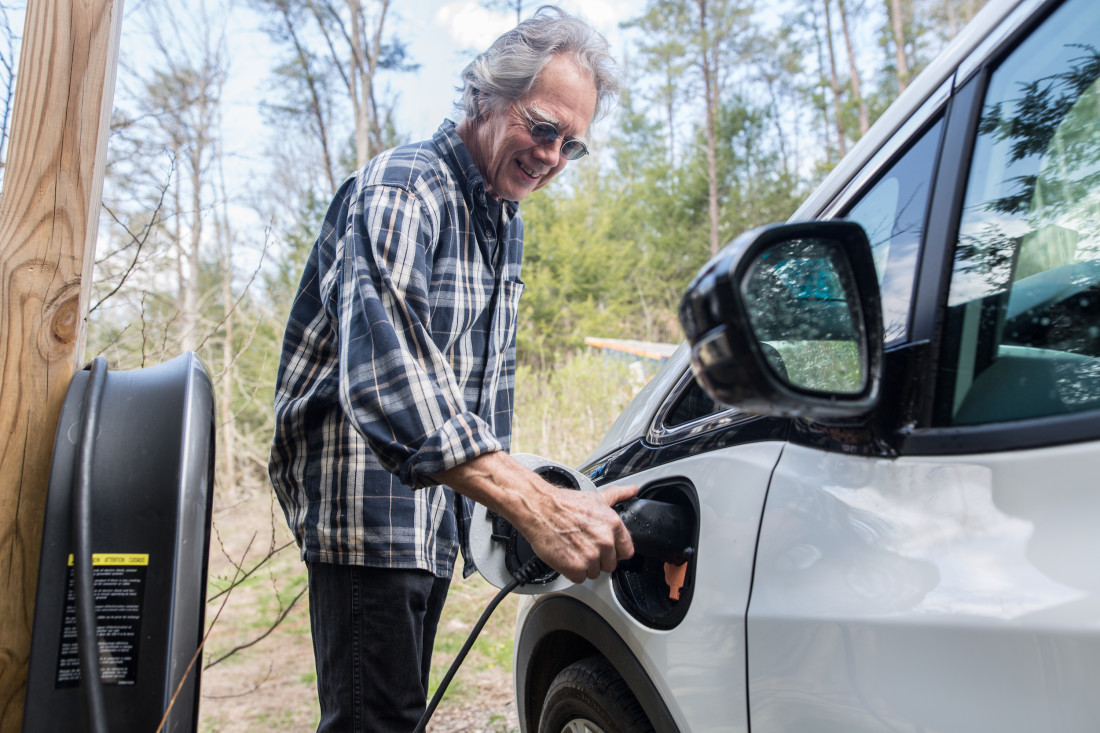Boone Guyton and his wife, Claudia Cady, have been living in their house in Alexander for 18 years. In 2010, they put a 4-kilowatt solar panel system on their roof and began generating a surplus of electricity each month. “We had the house part of our sustainable approach down pretty well,” said Guyton. “But our vehicles were still using nonrenewable energy.” For a while, Guyton and his wife drove a car that ran on biodiesel. “But we got to the point where we had this excess solar energy and then we found out that we could get a used lease on an electric car and the price was pretty reasonable.”
Taking advantage of North Carolina’s solar tax credits before they ended in 2015, Guyton added an extra 3-kilowatt solar panel system to his shed. He also added battery storage so that the electricity gathered from the sun during the day could charge his vehicle at night. “We figured that in order for the electric car to be a really sound environmental and carbon-saving approach, we should charge it with renewable energy.” Today, Guyton drives a Chevy Bolt that can run 238 miles on a single charge. “The electric car has no maintenance,” explains Guyton. “There’s no oil change, no tuneups.
Charging his car around town hasn’t been a problem, as electric vehicle charging stations are slowly popping up. “One of the charging stations down by the city permit office even has solar panels,” he says. “It’s a solar-assisted charging station.”
For Guyton, driving a vehicle that doesn’t use fossil fuels is one way he can personally fight climate change. “We’ve got to step it up,” he says. “I know a lot of solutions to climate change aren’t personal. But some are.”
Editor’s note: As part of our monthlong celebration of sustainable ways of living and working in our local community, Xpress is highlighting some of those who are taking action on a variety of creative and inspiring initiatives.



Pretty impressive! Cool too ;)
I’ve found that I’m doing better than net-zero with my solar panels. (That is I generate more than I use annually.) I’ve been weighing the environmental impact of my vehicle. My 2004 Prius still gets 40-50 mpg, with 152,000 miles on the ticker. Hard to figure if going to a Bolt, or similar NOW, makes more sense in the big scheme of things, or if driving the Prius to death first is best. There is embodied energy in every manufactured item. Selling my Prius wouldn’t take it off the road, but I guess it would be likely to increase someone else’s efficiency, assuming they would replace something with lower mpg. Thinking out loud here. Interested in whether anyone has done the hard calculation.
To Cecil’s comment: We don’t just throw cars away when we’re done with them. There’s a food chain. People who are rich enough to indulge in luxury buy new cars. (Even if it’s a strippo model Versa, Accent, or Spark, it’s still an indulgence compared to a used version of the same.) Value conscious rich people buy gently used late model cars. People with progressively less money buy progressively older cars in progressively worse shape. Truly poor people don’t own cars (or are poor partly because they have to own cars in order to live where they do, which may be necessary because the places they can afford lack good transit, pedestrian, and bicycle access). Even when a car is no longer drivable, it goes to a junkyard, where its parts get scavenged to keep others running.
But here’s where this gets interesting: New cars (luxury items bought by rich people) are the only kind of cars that auto manufacturers manufacture. Which means that rich people don’t just decide what rich people drive; they decide what every driver drives. Counterintuitive as it may seem, the best thing for the environment (if we’re going to continue driving cars) would be for rich people to buy the most environmentally benign new cars, and trade them frequently.
I have some excellent hard data on embodied energy, but it’s not readily at hand today, so I’ll just say for now that the embodied energy in cars (and photovoltaic panels, for that matter) is nowhere near as high as a lot of people would have you believe. Depending on the assumptions you make about usage, maintenance, recycling, etc., the embodied energy is comparable to a couple years of a car’s fuel consumption, nowhere close to what the car will use in its 20 year life. And, as described above, it’s a moot point anyway.